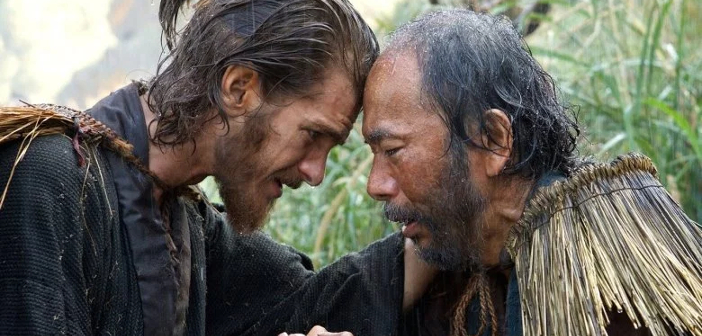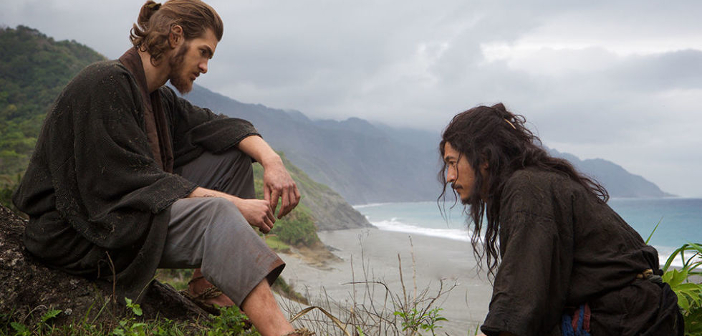Film Review | How Does Scorsese’s Historical Silence Match His Stylistic Oeuvre?
Although Silence lacks many of the showy stylistics of Martin Scorsese’s most popular works – Taxi Driver, Raging Bull, Goodfellas, The Departed, The Wolf of Wall Street – thematically it feels right at home in the auteur’s filmography. Religion, particularly but not exclusively Christianity, has often been a key feature within the filmmaker’s oeuvre. Take, for instance, The Last Temptation of Christ and Kundun, movies which both dramatize the lives of major religious figures, or other less obvious examples like Mean Streets, Bringing Out the Dead and Gangs of New York, in which faith is often a major source of conflict for its central characters.
Scorsese’s long gestating adaptation of Shusaku Endo’s 17th century-set novel of the same name stars an amazingly soulful Andrew Garfield as Fr. Rodrigues, a Portuguese Jesuit priest, who along with his colleague Fr. Garrpe (Adam Driver), journeys to Japan to find his mentor Fr. Ferreira (Liam Neeson). The Asian country is in the midst of one of the most violent religious inquisitions of all time, whereby the thousands of Catholics who crossed continents to spread the word of the Lord are being violently executed by the natives. Rodrigues’ experiences navigating Japan and being witness to countless atrocities causes the priest to question his faith and whether he is just “praying to silence”.

Silence is an incredibly illuminating account of a ferocious period of history. Scorsese’s script, which he co-wrote with Jay Cocks (The Age of Innocence, Gangs of New York), is filled to the brim with fascinating details regarding the faith-driven conflict. For a brief example, I knew Catholics were persecuted in genocide numbers. Yet, I was unaware that the inquisitors at one point stopped killing their enemies as they realised it made “martyrs” out of them. Instead, they took to other extreme and brutal measures in order to break them, causing priests to denounce their faith.
Its commentary on religion is too dense to sum up after one viewing but Cocks and Scorsese seem preoccupied with the clash between religious ideals and human flaws. It’s a juxtaposition that reoccurs throughout the film – in moments of levity such as when Rodrigues and Garrpe are served food by a secret community of Japanese Catholics and in their hunger, forget to say grace – and more dramatically when Rodrigues’ interpreter (Tadanobu Asano) is forced on numerous occasions to renounce God as a means of surviving.

Meanwhile, on a technical level, the film is astounding. In the way There Will Be Blood and The Revenant have become the blueprint for how to represent aesthetically their respective periods of history, Silence presents 17th century Japan much the same. Like Barry Lyndon, every scene looks like a gorgeous painting, while Kim Allen and Kathryn Kluge’s subtle but menacing score conveys the danger of the setting. As Ciaran Hinds’ high-ranking Jesuit tells Rodrigues’ early on: “The moment you set foot in that country, you step into high danger”. At times, Scorsese musters up an atmosphere of dread similar to Apocalypse Now, where behind every corner lurks peril for the central character as he searches for his own Col. Kurtz.
The movie isn’t flawless. Although for the most part it subverts the story’s potential for a white saviour narrative (Rodrigues’ actions lead to more death than saving), its presentation of its Asian players is noticeably one-dimensional. Issei Ogata’s character, who over the course of the drama comes to represent the inquisition, might as well twirl a moustache to convey how dastardly he is. It’s undoubtedly a fun performance, which, as some critics have noted evokes memories of Christoph Waltz’s Col. Landa from Inglorious Basterds – one scene in which he expresses dissatisfaction sees him deflating like a balloon. However, it feels too broad and simple in such a complicated film.
[arve url=”https://www.youtube.com/watch?v=ASU4wvY0CbE” align=”center” maxwidth=”750"]
Another problem involves the sudden inclusion of a second narrator in the closing moments of the narrative, something which I can imagine working in the novel but doesn’t gel on-screen. After following Rodrigues’ for 140 minutes, it feels odd to turn one’s attention to a new character in the closing twenty.
Overall, I think critics will adore Silence due to how rich it is both technically and thematically. It’s a film that’s legacy will grow over time as scholars return to it to gleam new interpretations and readings. That said, more casual film goers may be left cold. It’s deliberately slow and either audiences will be hypnotised by its pace and be gripped by it or become frustrated and grow bored. Many at my screening were in the latter category. I was in the former.
Silence is in cinemas now.

